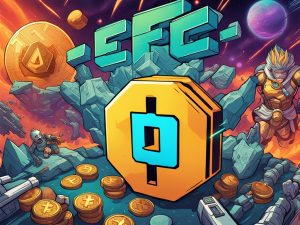Magic Eden Introduces cNFTs on Solana Blockchain
Magic Eden, a prominent player in the NFT marketplace, has announced its integration of cNFTs (compressed NFTs) on the Solana blockchain. These cNFTs offer a cost-effective alternative to traditional NFTs, allowing creators to produce content on a larger scale without high costs. This accessibility also benefits newcomers to the NFT space, making it easier for them to enter and experiment.
Controversies Surrounding cNFTs
Despite the advantages of cNFTs, there has been some controversy surrounding their introduction. Some members of the digital community criticized Magic Eden’s choice of the term “cNFT,” claiming it was already in use within the NFT ecosystem. In response, Magic Eden clarified that they were integrating support for cNFTs rather than creating them.
The Mechanics of cNFTs
cNFTs rely on Merkle trees, a data structure that compresses vast data trees into identifiable hashes. Solana Labs engineers have enhanced this compression technique, enabling multiple updates to Merkle trees within a single block. Developers interested in utilizing cNFTs need to understand Merkle trees and can mint these tokens using tools like Bubblegum by Metaplex.
Developers’ Requirements and Conclusion
For developers working with cNFTs, it is essential to have a comprehensive understanding of Merkle trees. To fetch real-time data, developers can rely on RPC platforms such as Helius, SimpleHash, and Triton. Additionally, modifying cNFTs requires Merkle tree proofs.
In conclusion, Magic Eden’s decision to support cNFTs showcases the evolving dynamics of the NFT market. As platforms push the boundaries of innovation, the broader community and industry stakeholders will closely monitor the adoption and implications of compressed NFTs.
Hot Take: The Potential Impact of cNFTs on the NFT Landscape
The introduction of cNFTs on the Solana blockchain has the potential to revolutionize the NFT landscape. By providing a cost-effective and accessible option for creators and newcomers alike, cNFTs can revitalize the market and make it more inclusive. Despite controversies surrounding their naming, cNFTs offer unique opportunities for experimentation and growth in the NFT space. As developers continue to explore the possibilities of cNFTs, we can expect further advancements and innovations that will shape the future of NFTs.
Magic Eden, a leading figure in the NFT marketplace, has unveiled its integration of cNFTs, a pioneering form of NFTs that are exclusive to the Solana blockchain. The term “cNFT” is an abbreviation for “compressed NFTs”, underscoring their unique capability to be crafted at a fraction of the cost of their traditional counterparts.
The announcement from Magic Eden delved deep into the potential of cNFTs. One of the primary advantages is their cost-effectiveness, which empowers creators to produce content on a grander scale without the hefty price tag. This not only paves the way for increased experimentation by creators but also provides a more accessible gateway for newcomers to the NFT realm. By making the entry point more affordable and less risky, Magic Eden believes that cNFTs have the potential to revitalize the NFT landscape, making it more vibrant and inclusive for collectors.
However, the introduction of cNFTs hasn’t been without its share of controversies. The choice of the term “cNFT” drew criticism from certain quarters of the digital community. A tweet from user @21e6Crypto on September 15 questioned Magic Eden’s decision to adopt an acronym that was already in circulation within the NFT ecosystem. Responding to the critique, Magic Eden clarified their stance, stating, “we didn’t create cNFTs, we integrated support for them.”
A deeper exploration into the mechanics of cNFTs reveals their foundational reliance on Merkle trees. This data structure is renowned for its ability to “compress” the verifiability of a vast data tree into a singular, identifiable “hash”. Solana Labs engineers have further refined this compression technique, introducing a capability that permits multiple simultaneous updates to Merkle trees within one block. This innovation is a hallmark of Solana, as detailed in their whitepaper.
For developers eager to harness the potential of cNFTs, a comprehensive understanding of Merkle trees is indispensable. Once the Merkle tree is initialized, NFTs can be minted using specialized tools. One such tool isBubblegum, a smart contract devised by Metaplex. To fetch the most recent data, developers would need to rely on RPCs, with platforms like Helius, SimpleHash, and Triton offering support for cNFTs. Lastly, to make any modifications to the NFTs, Merkle tree proofs are a prerequisite.
In conclusion, Magic Eden’s strategic decision to support cNFTs is a testament to the rapidly evolving dynamics of the NFT market. As platforms continue to push the boundaries of innovation, the broader community and industry stakeholders will be closely monitoring the adoption trajectory and broader implications of these compressed NFTs.





 By
By
 By
By
 By
By

 By
By
 By
By